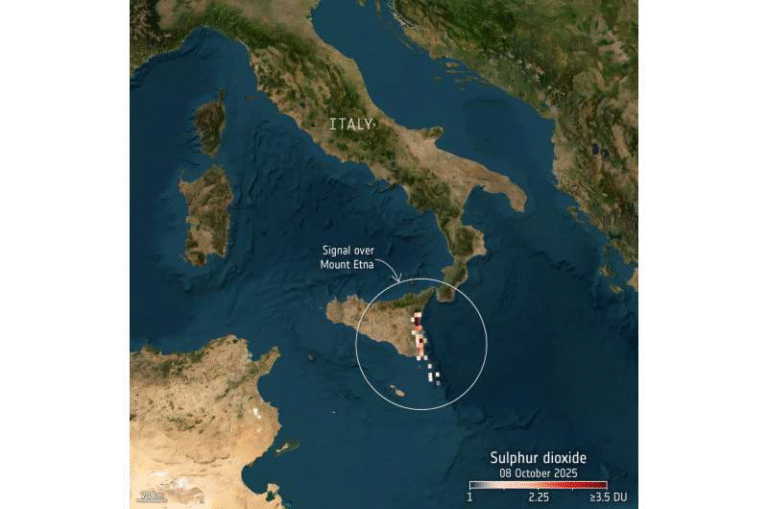Rare Meteoroid Impact on Mars Creates Over a Hundred New Slope Streaks and Reveals How Dust Moves Across the Red Planet

A rare meteoroid strike on the slopes of Apollinaris Mons has given scientists a remarkable opportunity to watch Mars reshaping itself in real time. The event set off a cascade of dust avalanches, forming more than a hundred fresh slope streaks that carved through the fine Martian dust. These new findings deepen our understanding of active surface processes on Mars and help clarify a mystery scientists have debated for decades.
The discovery comes from data captured by the Color and Stereo Surface Imaging System (CaSSIS) onboard the European Space Agency’s ExoMars Trace Gas Orbiter. On 24 December 2023, CaSSIS photographed a section of the Apollinaris Mons region — roughly six square kilometers in area — revealing striking new dark streaks stretching down steep slopes. The image was cataloged as MY37_027142_351, and the location is precisely 7.1°S, 173.4°E.
These streaks, which form when bright surface dust suddenly slides away to reveal darker material beneath, have long fascinated planetary scientists. What makes this case especially important is that the same CaSSIS image shows the faint cluster of impact craters at the base of the slopes. By comparing the new image with older ones, researchers determined that both the meteoroid impact and the formation of the streaks happened sometime between 2013 and 2017.
The ability to tie these features directly to a meteoroid strike is extremely unusual. According to new research, less than one in a thousand slope streaks on Mars are caused by impacts. Most form naturally from dry dust processes, driven by shifting seasonal patterns, wind, and sand movement. Scientists found no evidence of water involved in the formation of these streaks, reinforcing the idea that Mars today is a predominantly dry, dust-dominated world where fine particles play a major role in shaping the landscape.
This isn’t just speculation. A new study published in Nature Communications offers the most complete look yet at slope streak activity across Mars. Lead researcher Valentin Bickel from the University of Bern in Switzerland used advanced deep learning algorithms to analyze more than two million slope streaks recorded by NASA’s Mars Reconnaissance Orbiter (MRO). The analysis covered data from 2006 to 2024, allowing the team to build the first global census of these features.
The results revealed five major hotspots around the planet where slope streak formation is especially common. These hotspots reflect conditions where dust supply, steep topography, and seasonal winds intersect in just the right way. While the study did not list these hotspot locations in the news summary, MRO imagery over the years has shown recurring streak clusters in regions like Arabia Terra, Tharsis, and other high-dust environments.
Researchers observed that slope streaks tend to appear when fine dust layers become unstable, often in early morning or late afternoon hours, when temperature changes can influence dust movement. Seasonal wind activity — particularly during southern summer and autumn — seems to trigger most of these events. Only rarely do meteoroid impacts or marsquakes disturb the surface enough to generate streaks.
The study’s findings also help clarify a long-standing debate. For years, scientists questioned whether some slope streaks might be caused by briny water flows or subsurface moisture. The new data strongly supports the idea that nearly all slope streaks are produced by dry processes. Though the possibility of water elsewhere on Mars isn’t dismissed, these streaks specifically are now understood as dust-driven phenomena.
The ExoMars Trace Gas Orbiter (TGO) plays a crucial role in this kind of research. TGO is designed to study atmospheric gases, map potential water-rich regions, and analyze the planet’s surface in high detail — all part of the broader mission to understand Mars’ ancient history and potential habitability. The orbiter continues to deliver high-resolution images that help scientists watch the planet evolve over time.
These new observations highlight just how dynamic the Martian surface remains today. Dust movement, wind erosion, and slope instability all continue to shape the landscape, even in the absence of liquid water. This is important not only for understanding Mars’ past but also for preparing future missions. Dust activity affects lander safety, rover mobility, solar power efficiency, and even instrument calibration.
Below are additional details and context that help expand the picture of what scientists are learning about Martian slope streaks and dust activity.
What Exactly Are Slope Streaks?
Slope streaks are dark, narrow features that appear on steep Martian terrain such as crater walls, canyons, ridges, and volcano slopes. They form when a thin layer of bright dust slides away, exposing darker material beneath. Over time, the streaks lighten again as new dust settles.
They can span hundreds of meters and often resemble long, tapered brushstrokes. Unlike recurring slope lineae (RSL), which were once thought to involve salty water, slope streaks are now firmly recognized as dry dust avalanches.
Why the Apollinaris Mons Event Matters
The streaks triggered near Apollinaris Mons stand out for several reasons:
- The meteoroid impact is clearly visible in the image.
- The newly formed streaks are directly linked to that impact.
- Scientists could determine the time window of formation (2013–2017).
- It validates rare impact-triggered streak formation that models had predicted but seldom caught in action.
This makes it one of the cleanest examples of how an external force — instead of seasonal dust activity — can generate streaks.
The Role of Deep Learning and Big Data
Identifying over two million streaks manually would be impossible. That’s where machine learning came in.
Valentin Bickel and his team used deep learning techniques to process massive image datasets from MRO’s HiRISE and CTX cameras. The algorithms:
- Detected streak shapes and edges
- Classified their formation patterns
- Mapped their geographic distribution
- Compared them across different years
This large-scale approach gave scientists statistical confidence in understanding how frequently streaks form and what likely causes them.
What This Means for Future Mars Missions
Understanding dust movement is crucial because dust is one of the biggest operational challenges on Mars. It affects:
- Rover performance (dust on solar panels)
- Landing hazards (dust cover hides terrain features)
- Atmospheric clarity
- Thermal regulation of equipment
The dynamic nature of slope streaks shows that surface dust is constantly shifting, which future missions must account for.
What We Still Don’t Know
Even with millions of streaks catalogued, some questions remain open, such as:
- Why only certain regions become hotspots
- How deep the dust layers involved actually are
- Whether subsurface processes play any role at all
- How atmospheric cycles influence streak timing
As TGO and MRO continue collecting data, scientists will refine these insights.
Reference to the Research Paper
Dust, sand and wind drive slope streaks on Mars
https://doi.org/10.1038/s41467-025-65522-4





